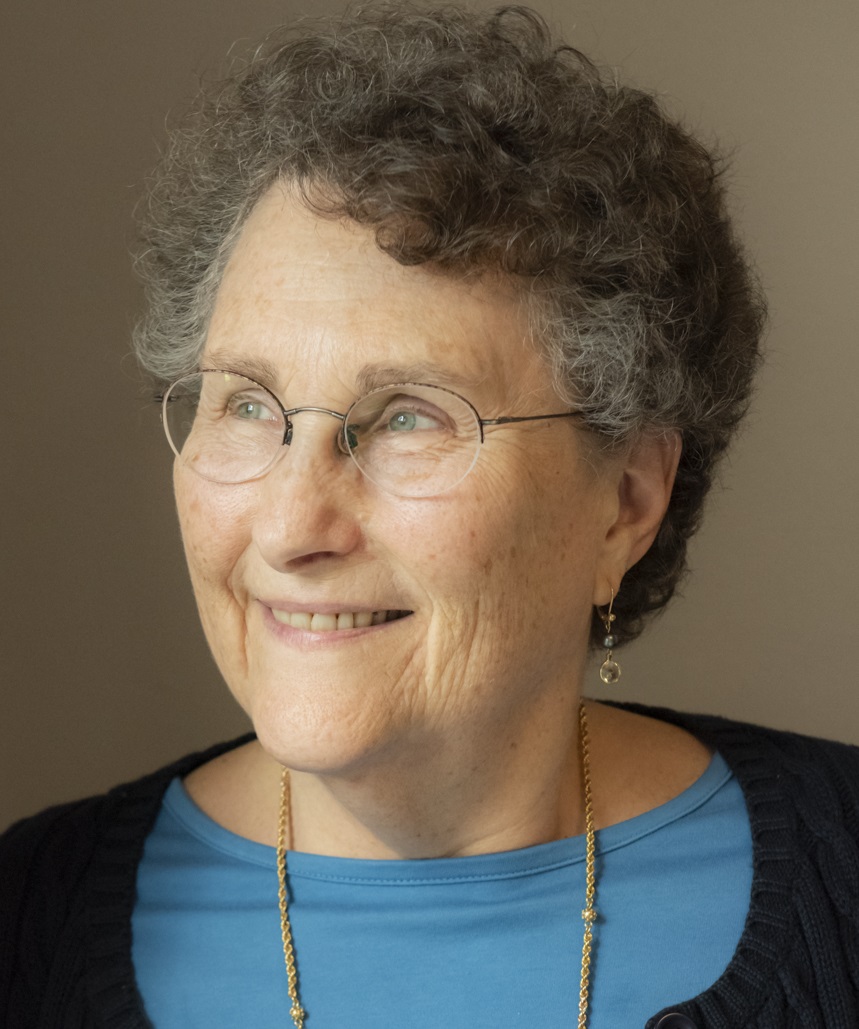Spiritual practices and “life-giving, non-cerebral prayer”
Lynne Baab • Tuesday August 29 2023

After my first post on Christian meditation, where I discussed the purpose of meditation for Christians, I got an interesting email from my friend Viv. She describes herself as “an ‘active senior’ Presbyterian minister who has also served in the Baptist movement." In Viv’s email, she said she “lives in the cognitive” and is a “studious introvert whose main pathway to the sacred is thinking and sorting.” Viv wrote that she has learned that many spiritual disciplines can “lift me into God's presence in life-giving, non-cerebral prayer.” She believes that too often we look to spiritual practices to help us live in a predictable way and feel safe. She said as a person whose spirituality has been so heavily cognitive, she needs encouragement to “step into the unknown.”
Viv mentioned the interchange between Susan, Lucy, and Mr. Beaver in The Lion, The Witch, and the Wardrobe when Susan says she is nervous about meeting the lion Aslan, C. S. Lewis’s Christ figure. Both Susan and Lucy wonder if he’s safe. Mr. Beaver replies, “Who said anything about safe? ’Course he isn’t safe. But he’s good. He’s the King.” [1]
My friend mentioned numerous spiritual practices that have helped her experience “life-giving, non-cerebral prayer.” As I list them, I will provide links to posts in this series or elsewhere on this blog about those practices:
- Christian meditation
- Lectio divina and other Ignatian practices
- Appreciation of nature
- Walking with the psalms
- Breath prayers
- Journaling
- Silent retreats
Referring to my post where I described possible purposes of Christian meditation, Viv wrote, “I love all your proposed ‘purposes,’ especially ‘experiencing Jesus’s companionship in daily life.’” Her words made me realize that when I think about walking with Jesus, I think mostly of receiving encouragement, peace, and empowerment as I talk with him. But as I thought more deeply, I recognized that I also receive Holy Spirit nudges to do things I don’t actually want to do, such as show care to someone I’d rather avoid, pray for people on the other side of the political spectrum, or look again at how much money we can give away this year. Those unexpected and uncomfortable nudges are some examples of God's guidance through prayer that leads me into “stepping into the unknown.”
Over the past five years, I have experienced a growing passion to help people pray more often and more easily. I want to provide resources, information, and encouragement so my readers can develop habits that make it comfortable to enjoy God’s presence. I want to help people identify the places and situations where prayer comes easily, and I want to encourage them to go there. I want to encourage the kinds of Bible reading, Bible study, experience of nature, and reflection that lay a strong foundation for prayer. Basically, I want to make prayer more natural and comfortable.
Viv’s email made me realize that I have neglected to emphasize the distinctly uncomfortable aspect of drawing near to Jesus and listening to the Holy Spirit. This Lion of the Tribe of Judah, who is good but not safe, demands our whole beings and pushes us into uncomfortable actions so we will reflect his values and show his love.
The goodness of this Lion, King Jesus, brings transformation in the midst of the challenges of following him.
When we pray in ways that open us to hear the Holy Spirit’s nudges, and when we respond in obedience, we are being transformed into the image of Jesus. We become more like this beloved Savior, Friend, and King, who knew exactly who he was and what his purpose on earth was. He walked in close communion with his Father, and “for the sake of the joy that was set before him endured the cross, disregarding its shame, and has taken his seat at the right hand of the throne of God” (Hebrews 12:2). I want that joy.
God who made us and calls us Beloved, God who redeemed us and made us whole, give us eyes and ears to perceive the ways you invite us into life-giving, non-cerebral prayer. Help us listen when you call us to do the unexpected. Help us embrace stepping into the unknown. We do want to be transformed into your image, and we ask that you give us your peace and joy in the midst of all of it.
(Next week: Spiritual practices, being/doing, and prayer. This is the 16th post in a series on spiritual practices and prayer. If you’d like to learn more about spiritual practices, the first post of the series is here. That post also has a list of all the posts in the series thus far. Illustration by Dave Baab: Karitane, New Zealand. If you’d like to receive an email when I post on this blog, sign up below under “subscribe.”)
Since I’ve given you so many links to previous posts in the bullet points above, this week I want to highlight my latest book, Two Hands: Grief and Gratitude in the Christian Life, available in paperback, audiobook, and for kindle. The book is based on a quotation about the importance of learning to hold grief in one hand and gratitude in the other. That quotation, which I came across right before the pandemic, gave me a significant shift in perspective. I had believed that if we embrace thankfulness enough, we won’t feel grief. Instead, so much of the Bible encourages us to grieve human brokenness at the same time as we thank God for the amazing gifts around us.
[1] C. S. Lewis, The Lion, the Witch, and the Wardrobe (New York: Macmillan, 1950), 64.
Next post »« Previous post
Subscribe to updates
To receive an email alert when a new post is published, simply enter your email address below.

Lynne M. Baab, Ph.D., is a teacher and writer. She has written numerous books, Bible study guides, and articles for magazines and journals. Lynne is passionate about prayer and other ways to draw near to God, and her writing conveys encouragement for readers to be their authentic selves before God. She encourages experimentation and lightness in Christians spiritual practices. Read more »
Lynne is pleased to announce the release of her book on grief and gratitude, designed to help people grieving from anything, including the pandemic, while also desiring to notice God's good gifts. Two Hands: Grief and Gratitude in the Christian Life is available in paperback, audiobook, and for kindle. Lynne's 2018 book is Nurturing Hope: Christian Pastoral Care for the Twenty-First Century, and her best-selling book is Sabbath-Keeping: Finding Freedom in the Rhythms of Rest (now available as an audiobook as well as paperback and kindle). You can see her many other book titles here, along with her Bible study guides.
Lynne recently spoke about empathy and also about bringing spiritual practices to life.
Lynne was interviewed recently for the podcast "As the Crow Flies". The first episode focuses on why listening matters and the second one on listening skills.
Here are two talks Lynne gave on listening (recorded in audio form on YouTube): Listening for Mission and Ministry and Why Listening Matters for Mission and Ministry.
"Lynne's writing is beautiful. Her tone has such a note of hope and excitement about growth. It is gentle and affirming."
— a reader
"Dear Dr. Baab, You changed my life. It is only through God’s gift of the sabbath that I feel in my heart and soul that God loves me apart from anything I do."
— a reader of Sabbath Keeping
Subscribe
To receive an email alert when a new post is published, simply enter your email address below.
Featured posts
- Drawing Near to God with the Heart: first post of a series »
- Quotations I love: Henri Nouwen on being beloved »
- Worshipping God the Creator: the first post of a series »
- Sabbath Keeping a decade later: the first post of a series »
- Benedictine spirituality: the first post of a series »
- Celtic Christianity: the first post of a series »
- Holy Listening »
- A Cat with a Noble Character »
- Welcome to my website »
Tags
Archive
- April 2024 (4)
-
March 2024 (5)
- Friendship, loneliness, and prayer: Praying about distractions from empathy
- Friendship, loneliness, and prayer: Praying to keep empathy flowing
- Friendship, loneliness, and prayer: Everyday initiative
- Friendship, loneliness, and prayer: Praying for guidance for ending conversations
- Friendship, loneliness, and prayer: Reflecting on the series
- February 2024 (4)
- January 2024 (2)
-
December 2023 (6)
- Friendship, loneliness, and prayer: Initiating
- Friendship, loneliness, and prayer: Praying about listening roadblocks
- Friendship, loneliness, and prayer: Praying to love the poverty in our friends
- Friendship, loneliness, and prayer: Praying for “holy curiosity”
- Friendship, loneliness, and prayer: Praying for “holy listening”
- Friendship, loneliness, and prayer: Praying to give affection extravagantly
- November 2023 (4)
-
October 2023 (5)
- Friendship, loneliness and prayer: A listening skill with two purposes
- Friendship, loneliness, and prayer: Saying “thank you” to friends
- Friendship, loneliness, and prayer: One more way reflecting helps us
- Friendship, loneliness, and prayer: Lessons from two periods of loneliness
- Friendship, loneliness, and prayer: Types of reflecting, a listening skill
- September 2023 (4)
- August 2023 (4)
- July 2023 (5)
- June 2023 (3)
- May 2023 (6)
- April 2023 (4)
- March 2023 (4)
- February 2023 (4)
- January 2023 (4)
- December 2022 (5)
- November 2022 (1)
- October 2022 (5)
- September 2022 (5)
-
August 2022 (6)
- Draw near: Confessing sin without wallowing
- Draw near: A favorite prayer about peace, freedom, and much more
- Drawing near with Desmond Tutu: God’s love is the foundation for prayer
- Draw near: Worshipping God with Desmond Tutu
- Draw near: Yearning, beseeching and beholding with Desmond Tutu
- Draw near: Praising God with Desmond Tutu
- July 2022 (2)
- June 2022 (6)
- May 2022 (5)
- April 2022 (6)
- March 2022 (5)
- February 2022 (4)
- January 2022 (3)
- December 2021 (5)
- November 2021 (4)
- October 2021 (5)
- September 2021 (4)
- August 2021 (4)
- July 2021 (4)
- June 2021 (4)
- May 2021 (4)
- April 2021 (5)
- March 2021 (4)
- February 2021 (4)
- January 2021 (4)
- December 2020 (5)
- November 2020 (3)
- October 2020 (5)
- September 2020 (4)
- August 2020 (4)
- July 2020 (5)
- June 2020 (4)
-
May 2020 (4)
- Spiritual diary of sheltering in place: The lifeline of separating thoughts from feelings
- Spiritual diary of sheltering in place: The lifeline of welcoming prayer
- Spiritual diary of sheltering in place: a kite string as a lifeline
- Spiritual diary of sheltering in place: The lifeline of God’s distant future
-
April 2020 (7)
- Spiritual diary of self-isolation: the lifeline of God’s constancy
- Spiritual diary of sheltering in place: The lifeline of accepting my place as a clay jar
- Spiritual diary of sheltering in place: the lifeline of memories
- Spiritual diary of sheltering in place: the lifeline of “Good” in “Good Friday”
- Spiritual diary of sheltering in place: The lifeline of “easier does not mean easy”
- Spiritual diary of sheltering in place: The lifeline of nature
- Spiritual diary of sheltering in place: the lifeline of God’s voice through the Bible
-
March 2020 (7)
- Important anniversaries in 2020: The first Earth Day in 1970
- Important anniversaries in 2020: Florence Nightingale was born in 1820
- Spiritual diary of self-isolation: Weeks 1 and 2
- Spiritual diary of self-isolation: God's grace as a lifeline
- Spiritual diary of self-isolation: The lifeline of limits on thoughts
- Spiritual diary of self-isolation: Wrestling with God for a blessing
- Spiritual diary of self-isolation: responding to terror by listening to Jesus voice
- February 2020 (4)
- January 2020 (5)
- December 2019 (4)
- November 2019 (4)
- October 2019 (5)
- September 2019 (4)
- August 2019 (5)
- July 2019 (4)
- June 2019 (4)
- May 2019 (5)
- April 2019 (4)
- March 2019 (4)
- February 2019 (4)
-
January 2019 (5)
- Nurturing friendships in a cellphone world: Jesus as Friend
- Nurturing friendships in a cellphone world: Friendship with Christ and friendship with others
- Nurturing friendships in a cellphone world: Who is my neighbor?
- Nurturing friendships in a cellphone world: Friendship as action
- Nurturing friendships in a cellphone world: Hymns that describe friendship with God
- December 2018 (3)
-
November 2018 (5)
- Connections between the Bible and prayer: Sensory prayer in Revelation
- First post in a new series: Nurturing friendships in a cellphone world
- Nurturing friendships in a cellphone world: Strong opinions and responses
- Nurturing friendships in a cellphone world: My conversation partners about friendship
- Nurturing friendships in a cellphone world: Two views about communication technologies
- October 2018 (4)
- September 2018 (4)
-
August 2018 (5)
- Providing Christian Care in Our Time
- Providing Christian care in our time: Seven trends in pastoral care today
- Providing Christian Care in Our Time: Skills for Pastoral Care
- Providing Christian care: The importance of spiritual practices
- First post in a new series: Connections between the Bible and prayer
- July 2018 (4)
- June 2018 (4)
- May 2018 (5)
- April 2018 (4)
- March 2018 (5)
- February 2018 (4)
- January 2018 (4)
- December 2017 (5)
- November 2017 (4)
- October 2017 (4)
- September 2017 (5)
- August 2017 (4)
- July 2017 (4)
- June 2017 (4)
-
May 2017 (5)
- My new spiritual practice: Separating thoughts from feelings
- My new spiritual practice: Feeling the feelings
- My new spiritual practice: Coping with feelings that want to dominate
- My new spiritual practice: Dealing with “demonic” thoughts
- My new spiritual practice: Is self-compassion really appropriate for Christians?
- April 2017 (4)
- March 2017 (5)
- February 2017 (4)
- January 2017 (4)
- December 2016 (5)
- November 2016 (4)
- October 2016 (4)
- September 2016 (5)
- August 2016 (4)
- July 2016 (4)
- June 2016 (4)
- May 2016 (5)
- April 2016 (4)
- March 2016 (5)
- February 2016 (4)
- January 2016 (4)
- December 2015 (4)
- November 2015 (4)
- October 2015 (5)
- September 2015 (4)
- August 2015 (4)
- July 2015 (4)
- June 2015 (4)
- May 2015 (4)
- April 2015 (6)
- March 2015 (4)
- February 2015 (4)
- January 2015 (4)
- December 2014 (5)
- November 2014 (4)
- October 2014 (4)
- September 2014 (4)
- August 2014 (5)
- July 2014 (4)
- June 2014 (7)





















